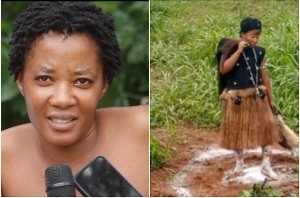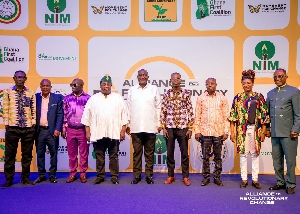 President Nana Addo Dankwa Akufo-Addo
President Nana Addo Dankwa Akufo-Addo
The erstwhile NDC government’s calamitous errors in judgement or dreadful decision-making brought about massive economic collapse and it is unlikely that the infant NPP government will be able to turn things around within a short space of time.
Change, by definition, requires creating a new system, which in turn, requires effective team and leadership (Kotter 1990).
On the other hand, some experts contend that if change is a process of leading an organisation or a nation on a journey from its current state to a desired future state and handling all the problems that arise along the journey, then change concerns leadership as well as management (Gill 2003).
On 7th December 2016, Ghanaians reacted negatively to the apparent harsh economic conditions and opted for a change (voted massively for the NPP Party). A change many observers would blissfully refer to as macro and episodic.
Macro and episodic change, according to Weick and Quinn (1999), is: “infrequent, discontinuous and intentional.”
In theory, macro and episodic change is often viewed as ‘radical’ or ‘second order’ change.
More importantly, episodic change generally involves replacement of one strategy or programme with another (Weick and Quinn 1999).
It is worth stressing that on assumption of office , President Akufo-Addo quickly and diligently assembled his team with a view to working collaboratively to achieving the desired change.
And it goes without saying that a section of Ghanaians hastily fretted thy souls with dubieties and consistently posed: “are the appointees going to give us the needed change?”
Thus far there have been concerted efforts by Akufo-Addo’s government to concretise the Right to Development by seeking to implement ‘one district one factory, one million dollars per constituency, tax reductions, free SHS, a dam per village in the northern part of Ghana, among others.
As a matter of fact, it is expedient and a worthwhile for any authority to attempt to bridge social inequalities through rational distribution of national resources (Li, Savage, Ward 2008).
Suffice it to point out that as the international community heads toward implementing and monitoring the 2030 Sustainable Development Goals agenda, the human development approach remains useful to articulating the objectives of development and improving people’s well-being by ensuring an equitable, sustainable and stable world.
In a grand scheme of things, the process of development – human development - should at least create an environment for people, individually and collectively, to develop to their full potential and to have a reasonable chance of leading productive and creative lives that they value.
Thus, according to the UNDP, policy options for enhancing human development through work have to be built around three broad clusters: (1) creating more work opportunities to expand work choices, (2) ensuring workers’ well-being to reinforce a positive link between work and human development and (3) targeted actions to address the challenges of specific groups and contexts.
An agenda for action to build momentum for change is also needed in pursuing a three-pillar approach—a New Social Contract, a Global Deal and the Decent Work Agenda (UNDP, 2015).
Let me however emphasise that Akufo-Addo’s government would need to develop into effective team in order to be able to coordinate individual activities for pragmatic outcomes.
Suffice it to stress that a team is a group of individuals who are collectively accountable and responsible for specific outcomes, whose members have a high degree of interdependence and interaction (Baldwin, Bommer, and Rubin 2008).
In other words, teams are supposed to work collaboratively towards achieving a high level of performance, possess complementary skills, trust in one another, commit to a common purpose, and have goals (both explicit and implicit) for which members are held mutually accountable (Katzenbach and Smith 1993).
In theory, the aim of team collaboration is to fortify the effectiveness of service delivery by strengthening integrated working across board (D’Amour et al., 2005).
Interestingly, however, Moore (2007) postulates that despite its importance, collaborative working has been identified as extremely complex due to diversities and disparities in professional practice such as values and professional inequalities.
There is also a contending school of thought that argues that collaborative working is often marked by fragmentation, competing priorities, arbitrary divisions of responsibility, inconsistent policy, unpooled resources and unshared boundaries (Hannigan, 1999).
Moreover, the absence of coordination, unpooled resources and lack of operational integration could produce wasteful and inefficient services (Hannigan, 1999).
In a grand scheme of things, team working has a perceptible likeness to “harnessing a crab, a swan, and a pike onto a single wagon and expecting them to move” (Tubin and Levin-Rozalis, 2008).
As a matter of fact and observation, the aforementioned creatures have dissimilar adaptations. And, obviously there is no propinquity between them. In other words, they differ in nature and more so culturally incongruous.
So in order to get them “moving” together effectively, they must first learn how to do that. In other words, they must undergo group process to unlock the innate barriers.
To put it metaphorically, tying “a swan, a crab and a pike” and tasking them to “move” together seamlessly without tackling the inherent barriers would be an uphill task by all means. For it is quite apparent that they would not be able to communicate properly with one another initially.
For example, “a swan may speak swanese language”; a crab speaks “crabi” language and a pike probably speaks “pikian” language.
Obviously, there are inequalities between them, although the three creatures all have some kind of sea life knowledge, But then again, they have differing adaptations. Take, for instance, a swan can fly, a crab can only probably swim and crawl, on the other hand, a pike cannot fly but may swim adequately. In essence, they may not understand each other, hence the need to assimilate or to undergo group process.
In a way, the preceding scenario explains the inequalities and the seeming challenges that confront professional groups that seek to work collaboratively.
As a matter of fact, a team is a very special form of group. Members cooperate and voluntarily coordinate their work.
And, within the team there should be a high level of cohesion, participation, support and shared values, and, in order to reach this important stage of maturity, teams need to develop and blossom.
In sum, the dynamics of a team are highly complex, hence getting teams in the calibre of President Akufo-Addo’s to work effectively may take time, so to speak.
By and large, despite the apparent umpteen challenges associated with team working, some optimists however contend that in the presence of periodic on-job training, effective interactions, information sharing, mutual respect and understanding, the team can work synergistically towards achieving a common goal (Reeves et al. 2009).











